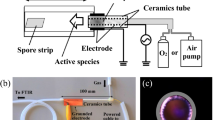Abstract
THE dissociation of oxygen in a glow discharge depends markedly on the presence of additives, in particular molecules containing hydrogen and nitrogen1–3. Brown3, for example, found that the conversion to oxygen atoms in a microwave discharge at a pressure of 0.52 torr increases from 0.015 for very pure oxygen to 0.23 when 2 per cent water vapour is added. Kaufman4 has attributed this effect to a reduction in the surface activity for recombination. There is, however, a lack of quantitative data on how both additives and the surface of the discharge tube and tube immediately downstream from the discharge affect the conversion to oxygen atoms. Their effect on the yield of oxygen atoms, expressed by g atoms produced/kWh of energy absorbed by the gas, is also poorly known. We present here some results of conversion to oxygen atoms and yields obtained when dry and moist oxygen were decomposed by microwave energy in poly-tetrafluoroethylene (PTFE), uncoated quartz and quartz tubes coated with syrupy orthophosphoric acid.
This is a preview of subscription content, access via your institution
Access options
Subscribe to this journal
Receive 51 print issues and online access
$199.00 per year
only $3.90 per issue
Buy this article
- Purchase on Springer Link
- Instant access to full article PDF
Prices may be subject to local taxes which are calculated during checkout
Similar content being viewed by others
References
Kaufman, F., and Kelso, J. R., J. Chem. Phys., 32, 301 (1960).
Shaw, T. M., in Formation and Trapping of Free Radicals (edit. by Bass, A. M., and Broida, H. P.), 47 (Academic Press, New York, 1960).
Brown, R. L., J. Phys. Chem., 71, 2492 (1967).
Kaufman, F., Chemical Reactions in Electrical Discharges, Adv. in Chem. Series, No. 80, 29 (A.C.S., Washington).
Fehsenfeld, F. C., Evenson, K. M., and Broida, H. P., Rev. Sci. Instrum., 36, 294 (1965).
Kaufman, F., Proc. Roy. Soc., A, 247, 123 (1958).
Kaufman, F., and Kelso, J. R., Disc. Faraday Soc., 37, 26 (1964).
Author information
Authors and Affiliations
Rights and permissions
About this article
Cite this article
MEARNS, A., MORRIS, A. Production of Oxygen Atoms in Quartz and Polytetrafluoroethylene Discharge Tubes. Nature 225, 59–60 (1970). https://doi.org/10.1038/225059a0
Received:
Issue Date:
DOI: https://doi.org/10.1038/225059a0
This article is cited by
Comments
By submitting a comment you agree to abide by our Terms and Community Guidelines. If you find something abusive or that does not comply with our terms or guidelines please flag it as inappropriate.



